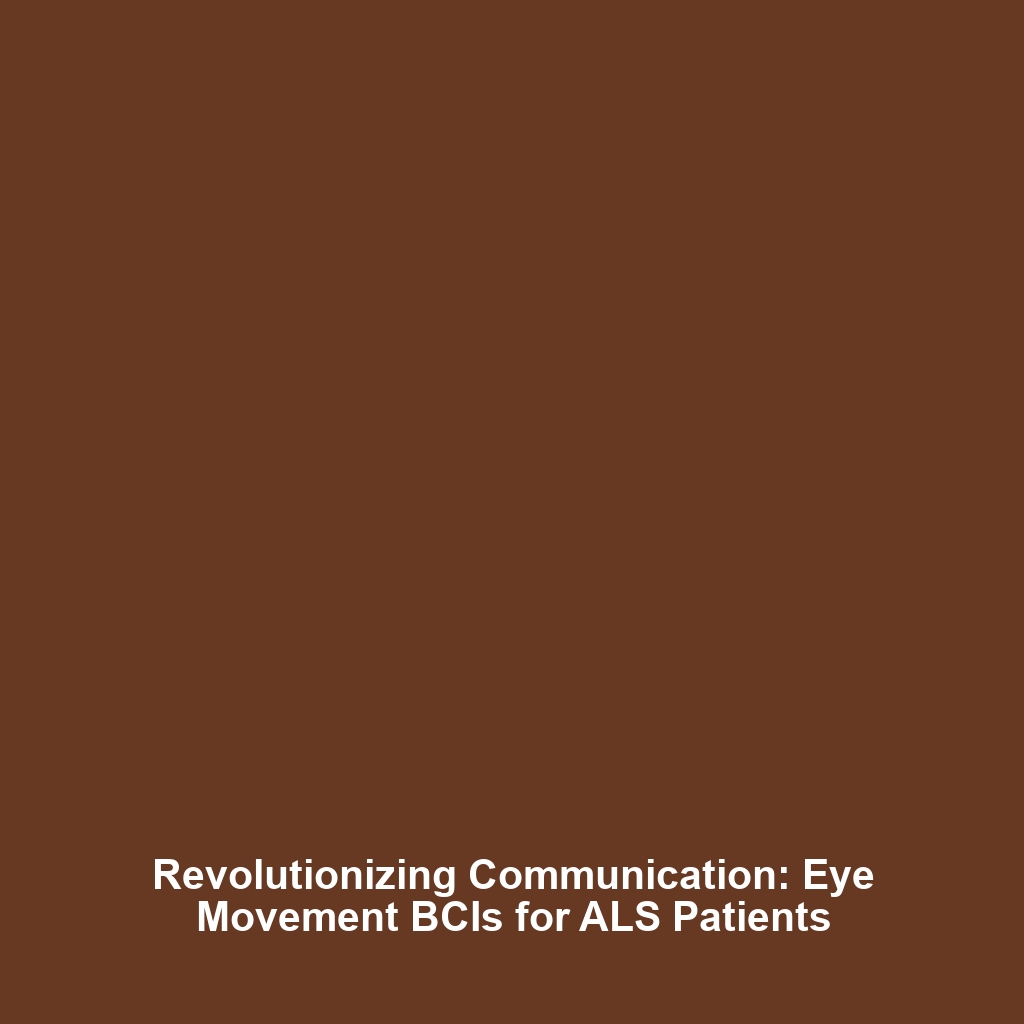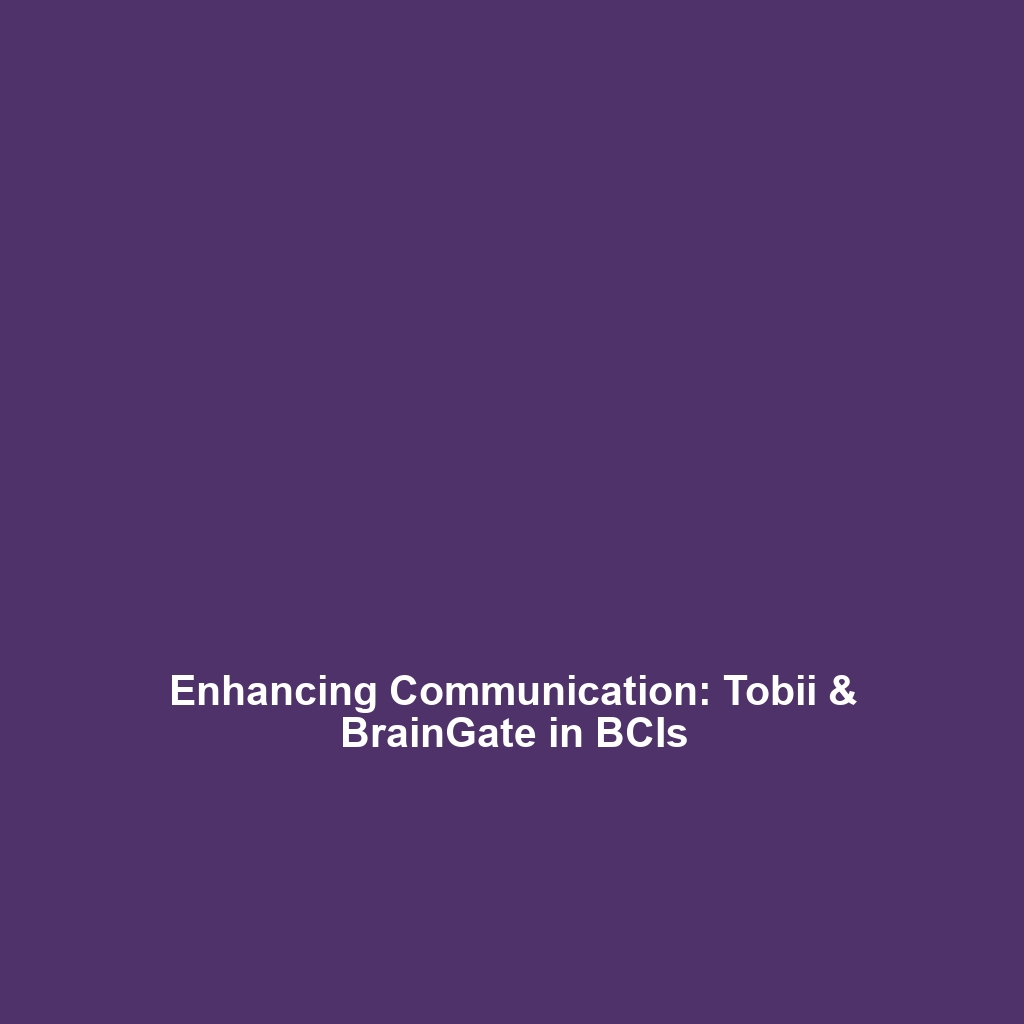Eye Movement BCIs: Transforming Communication for Patients with Motor Neuron Diseases
Category: Brain-Computer Interfaces
Topic: Eye movement BCIs: Patients with motor neuron diseases (e.g., ALS) can use BCIs paired with eye-tracking systems to control computers and communicate.
Introduction
In the realm of Brain-Computer Interfaces (BCIs), eye movement BCIs have emerged as a groundbreaking tool for patients suffering from motor neuron diseases, particularly amyotrophic lateral sclerosis (ALS). These cutting-edge technologies enable individuals to control computers and communicate effectively despite severe physical impairments. The integration of eye-tracking systems with BCIs is significant in enhancing the quality of life, allowing users to interact with their environment and express themselves with greater ease. As both technologies advance, the potential applications continue to expand, offering hope to those with limited mobility.
Key Concepts
Understanding eye movement BCIs involves grasping several key concepts:
What are Eye Movement BCIs?
Eye movement BCIs utilize devices that track the movement of the eye to translate visual inputs into commands. This technology relies on a combination of sensors and advanced algorithms to detect where a person is looking and convert that gaze into actions on a computer or communication device.
Integration with Motor Neuron Diseases
For patients with motor neuron diseases such as ALS, traditional methods of communication and interaction with technology become increasingly challenging. Eye movement BCIs provide an alternative means of engagement, empowering users to type, control devices, or communicate with others using only their eye movement.
Applications and Real-World Uses
The impact of eye movement BCIs on the lives of patients is profound. Here are some key applications:
- Assistive Communication: Eye movement BCIs are widely used in augmentative and alternative communication (AAC) devices, enabling users to generate speech or text purely through eye control.
- Environmental Control: These systems allow users to interact with their surroundings, controlling home automation systems, and appliances by moving their eyes.
- Gaming and Entertainment: Eye tracking technology has been integrated into gaming interfaces, allowing users to engage with entertainment platforms without physical inputs.
As such, the applications of eye movement BCIs in the field of Brain-Computer Interfaces demonstrate their versatility and potential to improve life for those with serious mobility challenges.
Current Challenges
Despite their transformative potential, eye movement BCIs face several challenges:
- Accuracy and Reliability: Eye-tracking technology can sometimes struggle with precision, particularly in patients with involuntary eye movements.
- User Training: Patients may require extensive training to become proficient in using eye movement BCIs, which can be a barrier to adoption.
- Cost and Accessibility: The cost of advanced eye tracking and BCI systems can limit access for some patients.
Addressing these challenges is crucial for optimizing the performance and accessibility of eye movement BCIs.
Future Research and Innovations
The future of eye movement BCIs is ripe with potential. Ongoing research is focused on:
- Improving Sensor Technology: Breakthroughs in sensor miniaturization and sensitivity can enhance the accuracy of eye tracking.
- Real-time Data Processing: Advances in algorithms may allow for rapid interpretation of eye movements, leading to more seamless user experiences.
- Combining Modalities: Future systems may integrate eye tracking with other physiological signals, offering even greater control options for users.
Such developments could significantly alter the landscape of Brain-Computer Interfaces and their applications in aiding communication for patients with ALS and other motor neuron diseases.
Conclusion
Eye movement BCIs represent a significant leap forward in assistive technology for patients with motor neuron diseases. By enabling these individuals to control computers and communicate effectively, these systems are not only improving quality of life but also expanding the horizons of what is possible for those with limited mobility. As research progresses, continued innovations will further enhance the capabilities and accessibility of these vital tools. To learn more about related technologies and their implications, consider exploring further topics on Brain-Computer Interfaces and their applications in modern healthcare.

